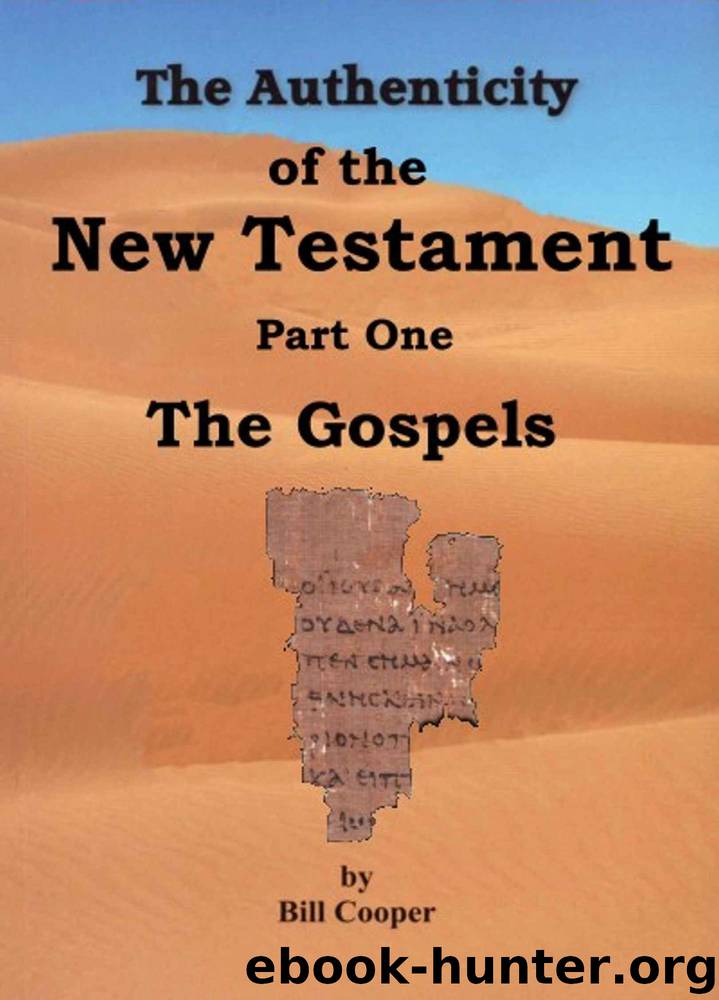The Authenticity of the New Testament Part 1: The Gospels by Bill Cooper

Author:Bill Cooper
Language: eng
Format: mobi, epub
Tags: Christian
Published: 2013-09-04T00:00:00+00:00
Contents
Chapter 6: The Authenticity of Mark’s Gospel
We have already seen that the Gospel of Mark – or several very early fragments of it – has been discovered in Cave 7 at Qumran.1 So we know from that one single fact that Mark was written and published well before AD 68, and belongs firmly, therefore, to the Eyewitness Period. That, at least, spares us the arduous labour of trying to argue an early authorship for Mark. Like Matthew, Mark could well have been in circulation as early as the late 30s or early 40s, within just a few years of the Resurrection. But that hasn’t stopped the critics from ‘having a go’ at it, and attempting by the most tortuous – not to say dishonest - means at their disposal to discredit Mark’s Gospel as a truthful record. But, have they succeeded?
The simple answer is no. After more than two hundred years of all-out effort, they haven’t. We shall see that Mark is as historically accurate in his statements as he possibly can be, but first we need to put to bed the persistent and time-worn accusation that the Gospel of Mark is mutilated – incomplete, corrupt, sawn off at the end and with bits fallen off. The verses in contention are the last twelve of the Gospel – Mark 16:9-20.
It is, to be sure, a recent accusation born of the German ‘Higher Critics’ of the 19th century that the original Gospel of Mark lacked the twelve verses that appear in its present-day form. However, those much closer in time to Mark were perfectly happy with these verses - and they could certainly spot a fraud when they saw one. The critics base their accusation on the fact that Codex Sinaiticus and Vaticanus – each of them containing 4th-century Gnostic mutilations of the New Testament – both omit Mk 16:9-20, and claim that the verses that we have today in our King James Bible were clearly added to the Gospel of Mark after these two codices were written – that is, at sometime after AD 400. But is there any factual basis to this contention? No, no there isn’t; quite the contrary in fact, and here’s why.
Papias alluded to Mk 16:18 in ca AD 100. How he might have achieved that feat if the verses had not been written and in circulation by his day is not explained. Likewise, Justin Martyr, writing in AD 151, directly quotes verse 20 of Mk 16. Irenaeus (ca AD 180) remarks on verse 19. Hippolytus, ca AD 200, quotes verses 17 and 18. In the Seventh Council of Carthage (AD 256), two of the verses were directly quoted, with none of the eighty-seven bishops present raising so much as an eyebrow. With truly delicious irony, the Acta Pilati (sometimes called the Gospel of Nicodemus), though a Gnostic work of the 3rd century, quotes verses 15-18 of this chapter. The so-called Apostolic Constitutions of the same century quotes verses 15 and 16. Eusebius, ca AD 325, discusses favourably at some length the entire section of Mk 16:9-20.
Download
The Authenticity of the New Testament Part 1: The Gospels by Bill Cooper.epub
This site does not store any files on its server. We only index and link to content provided by other sites. Please contact the content providers to delete copyright contents if any and email us, we'll remove relevant links or contents immediately.
| Buddhism | Christianity |
| Ethnic & Tribal | General |
| Hinduism | Islam |
| Judaism | New Age, Mythology & Occult |
| Religion, Politics & State |
Cecilia; Or, Memoirs of an Heiress — Volume 1 by Fanny Burney(32434)
Cecilia; Or, Memoirs of an Heiress — Volume 2 by Fanny Burney(31869)
Cecilia; Or, Memoirs of an Heiress — Volume 3 by Fanny Burney(31852)
The Secret History by Donna Tartt(18843)
Sapiens: A Brief History of Humankind by Yuval Noah Harari(14248)
Leonardo da Vinci by Walter Isaacson(13179)
The Radium Girls by Kate Moore(11921)
Sapiens by Yuval Noah Harari(5293)
How Democracies Die by Steven Levitsky & Daniel Ziblatt(5127)
The Wind in My Hair by Masih Alinejad(5033)
Homo Deus: A Brief History of Tomorrow by Yuval Noah Harari(4822)
Endurance: Shackleton's Incredible Voyage by Alfred Lansing(4676)
The Silk Roads by Peter Frankopan(4456)
Man's Search for Meaning by Viktor Frankl(4420)
Millionaire: The Philanderer, Gambler, and Duelist Who Invented Modern Finance by Janet Gleeson(4374)
The Rape of Nanking by Iris Chang(4136)
Joan of Arc by Mary Gordon(4013)
The Motorcycle Diaries by Ernesto Che Guevara(4009)
Hitler in Los Angeles by Steven J. Ross(3900)
